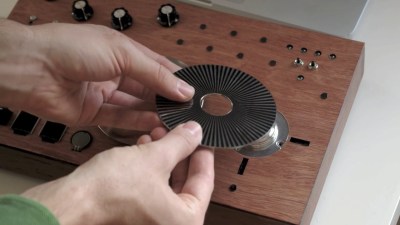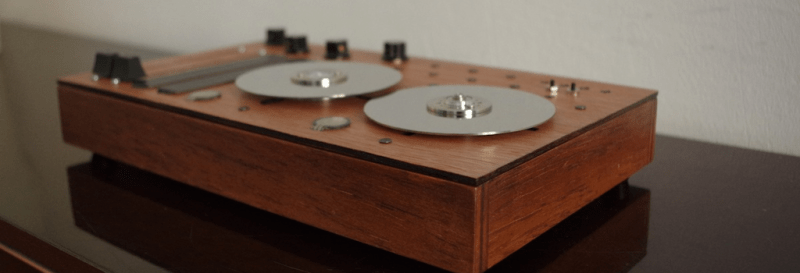It used to be that you had to spend real money to get an alternative controller for your electronic musical arsenal. These days, with cheap microcontrollers and easily-accessible free software libraries, you can do something awesome for pocket change. But that doesn’t mean that you can’t make a sexy, functional piece of art along the way! [Jan Godde] did just that with his cleverly named Wooden Sensor Box With Two Rotary Disks. (If you’ve got a better name for this thing, toss it in the comments.)
 From what we can see, the box has two potentiometer sliders, two touch-sensitive potentiometers, two force sensitive resistors, a slew of knobs, and a whole bunch of (capacitive?) touch points. In short, a ton of continuous controllers of all sizes and shapes in an aesthetic case. But stealing the show, and giving the device its name, are two platters from old hard drives that serve as jog wheels.
From what we can see, the box has two potentiometer sliders, two touch-sensitive potentiometers, two force sensitive resistors, a slew of knobs, and a whole bunch of (capacitive?) touch points. In short, a ton of continuous controllers of all sizes and shapes in an aesthetic case. But stealing the show, and giving the device its name, are two platters from old hard drives that serve as jog wheels.
As shown in the video below the break, the two jog wheels are covered with alternating stripes on the underside. Each platter has a dedicated pair of IR LEDs and photodetectors underneath serving as a quadrature encoder that allows [Jan] to tell which direction the platters are rotating, and how far.
We love the loopy Musique Concrète demonstration of the two jog wheels in action combined with the various sliders. It’s quite expressive and moody. But don’t neglect the utility of a bunch of (ten? twelve?) sensitive touch points. [Jan] demonstrates the touch points in this video. It’s amazing what you can do with a bunch of nails and some code!
And speaking of code, [Jan], we’d love to see what’s going on under the hood of this beauty. When you get the chance, toss us some schematics and code?
















beauteous build and clever repurpose of hard disk platters!
I agree. It always makes me happy when people put in the extra effort to make their builds look polished and professional.
I am just happy that the first comment wasn’t “I’ve seen this before!” because you haven’t. There are builds similar, sure, but this is a hack, undertaken by an individual with his own plans. RESPECT!
I’ve seen this before
Something like this: https://www.youtube.com/watch?v=DQk6oPvFeMY
Wooden Sensor Box With Two Rotary Disks
This seems like a name Leonard of Quirm would come up with. :-)
Make sure you wear a pair of gloves before handling those platters from the HDD or you get lot of finger prints on them that are a pain to remove. You want a clear coat on them ASAP .
Yep. It’s something of a tragedy to see those preternaturally clean and shiny platters take a perfect impression of your fingerprint, from the filth and ichor we’re constantly exuding from our filthy, disgusting bodies! Even a clear coat of varnish is going to diminish them immeasurably. I’m just gonna have a think about all those clean platters, safe in their hard drives forever, make me feel better.
Better name….Mr. Thingy!
i have a name! “The ElectRotator!”
http://orig13.deviantart.net/2b50/f/2010/079/5/f/electric_potato_by_kalec_the_archangel.jpg
This is the point where someone points out the HDD drive motor /already/ puts out a perfect quadrature signal, requiring only 3 comparators to bring the signals up to 3v3 or 5v, all without having to mess about with sticking stripes on the disks and all that optoelectronics, right?
Anyone?
Bueller?
Would the hard drive motor be able to give position output at very very low speeds and be accurate at such shallow angles as the masked stripes?
Was wondering the same…
Some motors might have hall-effects, though… But I haven’t seen ’em lately. Then, resolution…
But, actually, the signals from the windings would be analog, so maybe something of higher-resolution could be extracted at higher speeds with ADCs. Then, what would be the effect of running a small AC voltage across the windings… hmm… today’s mental exercise.
@Gartral: Excellent… but I think ElectroTator better, but maybe just ’cause it’s lunch time.
I tried some after reading this article. The ones I opened up here have 3 of 4 connectors. The 3 connector one was a 3 phase delta configuration. The 4 connector one was a 3 phase star configuration. They seem to have 9 poles per rotation or a very small number so they wouldn’t be any good for this due to the low resolution as you couldn’t really get an accurate speed reading.
Yeah, so 9 poles ‘vs’ the opto that looked like about 30 poles or more. And on top of the the interface would be a little more complex as the signal is analog and reverses polarity with direction and has back EMF of opposite polarity when the speed is changes suddenly.
I also made a driver board and tested then as motors. I tried 3 steps per cycle (x cycles per rotation) then 6 steps per cycle (3 micro steps) and then 256 micro steps.
You need to inject the right amount of energy into the coils or the thing is trying to jump from one position to the next which it can’t do because momentum of disk or even spindle so this is a waste of energy that dissipates as heat from the driver.
With things like floppy steppers you have four phases so you drive two at a time and you have 50% drive and 50% off so the magnetic flux dissipates. I don’t know what you should do with 3 phases … drive one and a half lol. Like half a hole.
well how un-fun is that? shhhh….
Wanted to point that out in the article — went with brevity.
FWIW, my scroll wheel on my desk as I type this is a full stack of HDD platters, read from the motor windings. It’s my daily driver, and I’d seriously think about switching up to something cleaner like optos.
I’ve never seriously debugged it (because it _does_ work) but I think that there’s a problem with inductance in the motor windings or maybe just bad debouncing. Anyway, I get reversals sometimes when stopping. I live with the glitches.
Ah, fair enough. I’ll admit, I only skimmed the article.
I’ve got a couple of HDD motors used as input devices, not come across reversals or significant glitching myself, but then I’m not daily drivering my stuff either. I can see how glitches on slowing down might well be extremely annoying. I have had (and continue to have) huge issues with optos, though. They really hate dust, hair, crud, etc.
I forgot to mention.
Nice project.
Wanna write that up? Might save what’s left of my wrist bones.
Except that its 3 phases instead of two and it’s bipolar in polarity and it’s amplitude varies with speed. And it has less than a tenth of the resolution of the opto one here.
Still useful for other things though. A distance measuring wheel comes to mind.
The motor AFAIK is a three phase delta. I wonder if it could be used instead of an optic quadrature. I will drive a motor to see the number of phases per rotation and the pulses (per phase) per rotation would obviously be the same.
Might be worth trying tossing a capacitieve sensor on the platters too, I imagine you could pick up some interesting stuff!